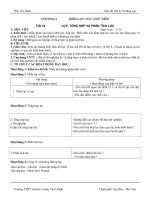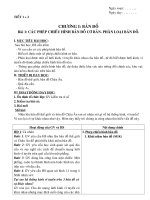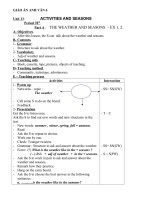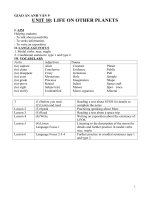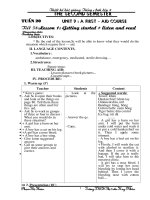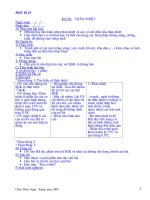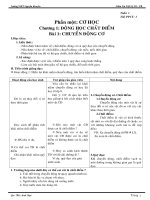Giáo án 10 (sách mới) kỳ 2 unit 8
Bạn đang xem bản rút gọn của tài liệu. Xem và tải ngay bản đầy đủ của tài liệu tại đây (199.36 KB, 21 trang )
Period: 73
Unit 8: new ways to learn
Lesson 1 - Getting started
A. Aims and Objectives:
- To teach Ss to listen and read a conversation about personal electronic devices and do tasks:
Questions & answers and true/ false exercises.
- To teach some lexical items related to:
+ Electronic devices that can help us learn
+ Using the Internet to learn English
- By the end of the lesson, students will be able to:
+ Use some lexical items related to personal electronic devices.
+ Make simple dialogues using the given expressions.
+ Master some vocabularies about personal electronic devices.
+ Get to know one grammar point.
B. Preparations:
- Teacher: Handouts, textbook, pieces of papers and cassette.
- Students: Textbook
C. Methods: - The whole lesson: Integrated, mainly communicative.
D. Procedures:
Time/Stages
Teacher’s Activities
1. Warm up
8 minutes
- Ask Ss these questions:
1. Have you ever owned any personal electronic
devices?
2. What are they used for?
- Leads in the new lesson
- Introduce the topic of the lesson:
New ways to learn
Activity 1: Listen and read
- Ask As look at the pictures and guess the topic of
the conversation.
- Have Ss predict what they are talking about
- Encourage all kinds of predictions
- Tell Ss not to worry about new words or grammar
points because these will be dealt with later.
- Play the recording
2. New
lesson
15 minutes
9 minutes
Activity 2: True/ False
What is the conversation about?
- Go through the statements to make senses quickly.
- Ask Ss do it individually in 5 minutes
- Encourage Ss to compare the answers with a
partner.
- Invite some Ss to give the answer and then explain
their choices.
- Give feedback to Ss’ work.
Key Answers:
1. F
2.F
3. NG
4. T
5. F
6. T
Activity 3:
- Have Ss work in pairs to find the adjectives which
Students’ Activities
- Answer the questions
- Look at the pictures and
guess
- Answer
questions
the
teacher’s
- Listen to the recording
- Read the statements
- Check the information in the
text.
- Do the task
- Some Ss give answers
- Listen to the feedback and
write down the right answers
- Work in pairs and do the
10 minutes
describe the devices used as learning tool then task.
discuss the meaning in five minutes
- Invite some Ss to give the words and the meaning. - Some Ss give answers
- Give feedback on Ss’ presentations
* Suggested answer:
1. personal: your own
2. electronic: having many small parts that control - Write down the answers
and direct a small electric current
3. modern: relating to the present time or recent
time
4. excellent: exceptionally good
5. useful: being of practical use
6. mobile: able to be moved easily
7. digital: showing information by using figures
8. perfect: being complete & without weaknesses
9. great: superior in quality or degree
Activity 4: Read the conservation again, and give
answers to the following questions.
- Tell Ss to focus on the instructions
- Checks Ss' understanding of the questions
- Set time for this activity, base on Ss’ level
proficiency
- Get Ss to work in pairs or groups to discuss the
answers.
- Call on different Ss to answer these questions
3.
Consolidation
2 minutes
4. Homework
1 minute
Answer Keys:
1. They are talking about smartphones, laptops and
tablet computers.
2. They have changed the way we learn.
3. They use them to take photos or record their
work, which can be later shared with the class.
4. because they can be used to store information,
take notes, write essays and do calculations.
5. He does his assignments and projects, and
studies English.
- Ask Ss: What have you learnt today? What can you
do now?
- Summarize the main points of the lesson.
- Ask Ss to learn by heart the words or phrases
related to the personal electronic devices.
- Prepare for the next lesson.
- Read the questions
- Go back to the text to find
out the answers.
- Ss can work in pairs/ groups
- Some Ss go to the board to
write answers
- Listen to the feedback and
write the answers
- Answer the questions
- Listen to the teacher
- Take note
E. Experience:
...................................................................................................................................................................................
...................................................................................................................................................................................
..
...................................................................................................................................................................................
.
...................................................................................................................................................................................
.
Period: 74
Unit 8: new ways to learn
Lesson 2 - Language
A. Aims and Objectives:
- To teach Ss to pronounce correctly three –syllable adjectives and verbs in isolation and in context.
- To teach Ss to use relative clauses: Defining and non-defining relative clauses with “who, that and
whose”
- By the end of the lesson, students will be able to:
+ Understand use relative pronouns and relative clauses.
+ Pronounce correctly three –syllable adjectives and verbs in isolation and in context.
+ Use some lexical items related to the topic New ways to learn in context.
B. Preparations:
- Teacher: Handouts, textbook, pieces of papers and cassette.
- Students: Textbook
C. Methods: - The whole lesson: Integrated, mainly communicative.
D. Procedures:
Time/Stages
1. Lead-in
3 minutes
Teacher’s Activities
- T informs the class of the lesson objectives:
Getting to know relative pronouns and relative
clauses.
Students’ Activities
- Listen to the teacher’s
instruction
2. New lesson
10 minutes
1. Vocabulary:
Activity 1: Matching
- Ask Ss to work individually, read the
phrases(1-5) then find the meaning for each of
them (a-e) in 3 minutes
-Elicit Ss to use the context of the conversation
to choose the meaning for each phrase.
* Key:
1. a
2. d
10 minutes
3. b
4. c
5. a
Activity 2:
- Invite some Ss to check the answers
-Ask Ss to work individually first, then check
with a partner.
- Check with the whole class and ask Ss if they
have ever used one of these devices and add
more uses if any.
* Key:
1. A,B,C
2. A, C
3. A, C
4. B
5. B
6. A,B, C
2. Pronunciation
Activity 1: Listen and repeat
- Play the recording for Ss to listen.
- play it again with pauses for Ss to listen and
repeat.
- Ask some Ss to read the words again and give
- Do the task individually
- Some Ss give the answers
- Write down the answers
- Do the task as be required
- Give the answers
- Check if the answers are correct
- Listen to the recording first
-
Listen
again
and
repeat
14 minutes
comment on Ss’ pronunciation
- Invite individuals Ss at random to read the
words. Correct them, if necessary
Activity 2:
- Focus on the stress patterns of three- syllable
adjectives and verbs.
- Ask Ss to listen and practice saying them
correctly
- Play the tape again. Ask Ss to put a mark
before the stress syllable in each word.
- Check with the whole class to make sure that
every student has done this exercise correctly.
* Key:
‘concentrate ‘similar
con’tribute
‘digital
intro’duce
‘excellent
‘recognise Vietna’mese
under’stand
‘personal
‘interest
sym’bolic
3. Grammar: Defining and non-defining
relative clauses
Activity 1:
- Ask Ss to read the sentences taken from
Getting started underlined the relative pronouns
and their functions.
- Revise the uses of the relative pronouns
through these sentences.
- Help Ss to distinguish defining relative clause
vs non-defining relative clause.
- Check Ss’ work and comment.
* Key:
1. that
2. which
3. That
4. which
5. whose
- These pronouns are used to define or identify
the nouns preceding them.
+ Defining relative clauses: 1,3,5
+ Non- defining R.Cs: 2,4
Activity 2:
- Have Ss work in pairs to match sentence part in
A with a suitable one in B in 4 minutes.
- Check some Ss’ answer and comment.
- Ask Ss to read watch out, check for
comprehension.
* Key:
1. e 2.d
3. a
4. f
5. c 6. b
Activity 3:
- Let Ss do this exercise in 4 minutes.
- Call some Ss at random to give the answer and
then give feedback to Ss’ work.
Answers:
1. which/ that
2. whose 3. which
4. who/ that
5. whose
6. who
simultaneously
- Some pronounce the words
- Listen again and put the mark (’)
before the stress syllables
- Check the correct answers and
take notes.
- Read the sentences and
underline the relative pronouns
- Recall the use of relative
pronouns
- Discuss with friends
- Listen to the teacher’s
explanation and take note
- Work in pairs and do the
matching
- Some Ss give answers
- Take note
- Do the task
- Some Ss give answers
- Listen to the teacher and write
down the answers
3.
- Ask Ss: What have you learnt today? What can
Consolidation you do now?
2 minutes
- Summarize the main points of the lesson.
4. Homework
1 minute
- T asks Ss to do exercises again at home.
- Prepare for the next lesson.
- Complete Exercises in workbook.
- Revise the lesson
- Listen and take note
E. Experience:
...................................................................................................................................................................................
...................................................................................................................................................................................
..
...................................................................................................................................................................................
...................................................................................................................................................................................
..
Period: 75
Unit 8: new ways to learn
Lesson 3 - Reading
A. Aims and Objectives:
- To teach Ss to read for general ideas and for specific information about new ways to learn English
and do tasks: Answer the questions and discuss.
- To teach Ss some words and phrases related to new ways to learn English.
- By the end of the lesson, students will be able to:
+ Read for general ideas and for specific information about new ways to learn English and
answer the questions.
B. Preparations:
- Teacher: Handouts, textbook, pieces of papers and cassette.
- Students: Textbook
C. Methods: - The whole lesson: Integrated, mainly communicative.
D. Procedures:
Time/Stages
Teacher’s Activities
1. Homework
8 minutes
- Ask two Ss to do the exercises with relative
clauses and then give comment and marks.
2. New lesson
Activity 1:
-Let Ss look at the pictures and answer the
questions.
1. What are students doing?
2. What is the reading text about?
1. They are using smartphones, and tablets to study
in the classroom.
2. We are going to read about electronic devices
which help us learn knowledge.
12 minutes
14 minutes
8 minutes
Activity 2:
- Check if Ss know the meaning of the words on the
left, explain these words if necessary.
- Have Ss match each of the words with its meaning
first then check with a partner.
- Go over the answer to make sure Ss have done
correctly.
* Answer:
1. c
2.d
3. a
4. e
5. f
6.b
Activity 3:
-Make sense of the three options.
-Ask Ss to read the text silently in 5 minute.
-Have Ss choose the best title and give their
explanation for their choice.
- Call one or two Ss to check the answer
* Key: b. New ways to learn English
Students’ Activities
- Some Ss do the exercises
- Check the answers
- Look at the pictures and
answer the questions
- Check the meaning of the
words
- Match the words with their
meanings
- Check if the answers are
correct
- Read the titles
- Read the text and decide
which is the best title
- Check the correct answers
Activity 4:
- Ask Ss to scan the text to find the answer for the
question.
- Have Ss in pairs ask and answer
- Check some pairs, give feedback to Ss’ answer.
* Key:
1. We can download them in mobile devices and
study anywhere.
2. We can see words on the screen and hear them
spoken.
3. We can choose to practice with native speakers
of different accents and genders.
4. We can use them to record real life English
speech, lessons, songs or English language films.
5. Because it will make learning English easier,
faster, more effective and more enjoyable.
Activity 5:
- Divide class into groups of 4 or 5 Ss and let them
discuss the question.
- Walk round to monitor the class and offer help.
- Invite two or three groups to report what they have
talked.
- Give comment to Ss’ talks.
* Suggested answers:
Some Ss in my groups have smartphones and
laptop. We use these devices to look up new words,
download and store digital lessons and practice.
These devices help us improve our pronunciation,
vocabulary and skills as well.
3. Consolidation
2 minutes
- Summarize the main points of the lesson
4. Homework
- Ask students to learn by heart the new words.
1 minute
- Prepare for the next lesson.
- Work in pairs to do this
activity.
-Take turns asking and
answering
- Give answers
- Write down the correct
answers
- Work in groups
- Ask the teacher if necessary
- Listen to the others’ groups
- Listen to the teacher
- Revise the lesson
- Listen and take note
E. Experience:
...................................................................................................................................................................................
...................................................................................................................................................................................
..
...................................................................................................................................................................................
...................................................................................................................................................................................
..
Period: 76
Unit 8: new ways to learn
Lesson 4 - Speaking
A. Aims and Objectives:
- To teach Ss to talk about how electronic can help us learn.
- To teach Ss to practise sharing and giving responses to new information.
- By the end of the lesson, students will be able to:
+ Express their opinion about how electronic can help us learn.
+ Give a report about how their classmates use the devices to learn school subjects.
+ Perform their viewpoints to other people in real life.
B. Preparations:
- Teacher: Handouts, textbook and pieces of papers.
- Students: Textbook
C. Methods: - The whole lesson: Integrated, mainly communicative.
D. Procedures:
Time/Stages
1. Warm up
8 minutes
2. New
lesson
8 minutes
7 minutes
8 minutes
8 minutes
Teacher’s Activities
Show several images of electronic devices on the
screen, ask Ss to write the names and how do they
help you learn at school?
* Suggested answer:
Personal computer, laptop, smartphone, tablet,
speakers
Activity 1:
- Give Ss time to read through the arguments in favor
of using electronic devices in learning and match
arguments 1-4 with explanations a-d
- Ask them to compare the answer with a partner.
- Call on some Ss to check
- Ask Ss to exchange the answer with a partner.
* Answer:
1.d
2. b
3. c
4. a
Activity 2:
- Guide Ss to understand the requirement of this
activity.
- Give Ss several ways to express their ideas about the
most effective ways of using electronic devices.
- Present a model
E.g. In my opinion, making learning and teaching
faster, easier and better is an effective way of using
electronics because teachers can use these devices to
prepare for the lesson, and students can look for
information on electronics.
- Have Ss, in pairs, to express their ideas.
-Call on some Ss to check.
Activity 3:
- Ask two Ss to model the example
- Have Ss discuss in pairs in 5 minutes.
-Walk round and offer help if necessary
Students’ Activities
- Look at the screen and write
the names of the electronic
devices
- Read the arguments and do
the matching individually
- Compare
friends
answers
with
- Check the correct answers
- Listen to the teacher’s
instruction
- Take notice of the model
- Work in pairs
- Some Ss give the answers
- Take notice of the examples
- Discuss in pairs
- Check two pairs and comment.
3.
Consolidation
2 minutes
4.
Homework
1 minute
Activity 4:
- Divide class into groups of 3 to 4 students, ask Ss to
focus on getting answer to the questions and note
down their group’s discussion in 4 minutes.
- Ask the representatives from some groups to report
the results of their group work to the class.
- Summarize what they have learnt by asking Ss some
questions:
What have you learnt today? What can you do now?
- Suggested answers:
+ I can talk about how electronic devices can help us
learn.
+ I can give a report about how their classmates use
the devices to learn school subjects.
- Ask students to learn by heart the expressions.
- Prepare for the next lesson.
- Listen and take note
- Work in groups
- Some representatives report
the discussion
- Revise the lesson
- Listen and take note
E. Experience:
...................................................................................................................................................................................
...................................................................................................................................................................................
..
...................................................................................................................................................................................
...................................................................................................................................................................................
..
Period: 77
Unit 8: new ways to learn
Lesson 5 - Listening
A. Aims and Objectives:
- To teach Ss listen to instructions on how to access and use online English language materials for
specific information.
- By the end of the lesson, students will be able to:
+ Listen and do the tasks.
+ Develop the listening skills for specific details.
+ Talk about how to use electronic devices to study English online.
B. Preparations:
- Teacher: Handouts, textbook, pieces of papers and cassette.
- Students: Textbook
C. Methods: - The whole lesson: Integrated, mainly communicative.
D. Procedures:
Time/Stages
1. Warm up
7 minutes
2. New
lesson
6 minutes
Teacher’s Activities
- Have students look at the pictures and elicit their
answers to the questions in the instructions.
Ex: What are the students doing?
What do you think you are going to listen about?
- Ask them to use the caption to help them guess.
Suggested answers:
The students are learning English with computers.
Maybe they are searching the Internet for
information or using a webpage to study.
We guess we are going to listen to some new ways
to learn using the Internet and electronic devices.
- After all, inform students of the lesson objective:
listening for specific information about using
electronic devices to study English.
* Pre-teaching vocabulary
- get tired of :
- search engine:
- level:
- record:
- native speaker:
- effectively:
- success:
- Teacher may give more explanation on the use of
these words and phrases.
Students’ Activities
- Look at the pictures and
answer the questions
- Give the answers
- Write down the words
- Listen to the teacher’s
explanation
Task 1: True or False?
9 minutes
- Ask Ss to read all the statements and guess if they
are true of false. Make sure that students understand
all the statements before listening.
- Explain if there are any new words. Give the
Vietnamese equivalents if necessary.
- Play the recording and have students do the
activity. Check their answers.
- Read the statements,
underline the key words
- Listen to the recording and
- Play the recording again if many students in the
class have incorrect answers, pausing at the places
where they can get the correct information.
*Key: 1. F
2. T
3. T
4. F
5. T
10 minutes
10 minutes
3.
Consolidation
2 minutes
Task 2: Listen again and complete the
following sentences by writing no more than
three words.
- Teacher asks students to read the instructions and
the sentences 1-5. Make sure that they understand
the sentences. Provide help with the new vocabulary
if necessary.
- Play the recording once or twice again
- Ask students to work with a partner to compare
their answers.
- Invite representatives from some pairs to report
their answers to the class. Give feedback and correct
any wrong answers.
Keys:
1. easily and effectively
2. access and take
3. learning vocabulary
4. native speakers
5. chance of success.
Task 3: Discussion
- Inform students that this is a post-listening activity.
- Ask students to work in groups of 3 or 4 and
discuss the questions. Students note down their
group members' answers and get ready to report.
Have some students present their reports to the class.
- Check and give feedback.
- Call on some Ss at random and have them express
their opinions to the whole class.
do the task
- Write down the correct
answers
- Read the sentences and try to
guess the part of speech of the
missing information
- Listen to the recording and
do the task
- Work with a partner
- Some representatives give
the answers
- Listen and take note
- Work in groups and discuss
the questions
- Some representatives give
the answers
- Listen and take note
- Ask Ss to consolidate the main contents.
- Ask Ss: What have you learnt today?
- Revise the lesson
What can you do now?
Expected answer:
+ I’ve learnt to instructions on how to access and use
online English language materials.
+ I can talk about how to use electronic devices to
study English online.
4.Homework
1 minute
- Prepare for the next lesson.
- Listen and take note
E. Experience:
...................................................................................................................................................................................
...................................................................................................................................................................................
..
...................................................................................................................................................................................
.
Period: 78
Unit 8: new ways to learn
Lesson 6 - Writing
A. Aims and Objectives:
- To teach Ss to write about the advantages and disadvantages of electronic devices as learning
tools.
- To teach Ss to talk about electronic devices used among children in the USA.
- By the end of the lesson, students will be able to:
+ Write about the advantages and disadvantages of electronic devices as learning tools.
+ Develop the writing skills in general. Build up vocabulary supported for writing.
+ Talk about electronic devices used among children in the USA.
B. Preparations:
- Teacher: Handouts, textbook and pieces of papers.
- Students: Textbook
C. Methods: - The whole lesson: Integrated, mainly communicative.
D. Procedures:
Time/Stages
1. Warm up
5 minutes
2. New
lesson
12 minutes
10 minutes
15 minutes
Teacher’s Activities
- Write the phrase Using electronic devices in learning
on the board. Focus on the pictures and the
instructions.
- Elicit students' ideas about the pictures. Give
suggestions by asking some questions to help students
think and talk about the advantages and disadvantages
of using electronic devices in learning.
Activity 1:
- Give students time to read the sentences about some
advantages and disadvantages of using electronic
devices in learning.
- Give the explanation and meaning of some new
words and phrases mentioned in the texts.
- Have them compare their answers with a partner
first, and then ask some students to read out loud their
answers to check as a class.
Key:
A: 2, 4, 6. D: 1,3,5
Activity 2:
- Give students time to read the text about the
disadvantages of using electronic devices in class.
- Elicit students' answers about the use of linking
words.
Linking words:
First of all, Second, Last but not least, In conclusion.
Activity 3:
- Ask students to read the sample writing again.
Remind them of the structure of a short text that starts
with a topic sentences, followed by supporting ideas
1,2,3 and ends with a concluding sentence.
- Tell students to write a draft first, then write a short
Students’ Activities
- Listen to the teacher’s
explanation
- Raise the ideas
- Read the sentences
- Listen to the teacher’s
instruction
- Write A for advantage and
D for disadvantage
- Check with the class
- Read the text and underline
the linking words
- Add more linking words
- Read the sample writing
again, then write a short text
about the advantages of
using electronic devices in
learning
3.
Consolidation
2 minutes
4.
Homework
1 minute
text about the advantages of electronic devices as
learning tools.
- Students write the text in class. When they finish, ask
them to exchange it with a partner for peer comments/
correction.
- Walk around and offer help if necessary.
- Alternatively, have students write the text at home.
- Collect students' papers in the next lesson. Give
feedback on some papers in class.
- Ask Ss to consolidate the main contents.
- Focus on the form of a biography
- Ask Ss to complete the writing at home and collect
- Ask Ss: What have you learnt today?
What can you do now?
Expected answer:
- I’ve learnt how to write a short text with supporting
ideas and detailed explanations.
- I can write about the advantages and disadvantages
of electronic devices as learning tools.
- Write the text again at home.
- Prepare for the next lesson.
- Ask the
necessary
teacher
- Revise the lesson
- Listen and take note
E. Experience:
...................................................................................................................................................................................
...................................................................................................................................................................................
..
...................................................................................................................................................................................
...................................................................................................................................................................................
..
if
Period: 79
Unit 8: new ways to learn
Lesson 7 - Communication and culture
A. Aims and Objectives:
- To teach Ss to talk about the electronic devices used among children in the USA.
- By the end of the lesson, students will be able to:
+ Understand and communicate about electronic devices used among children in the USA.
+ Talk about the electronic devices used among children in the USA.
+ Talk and express their ideas and opinions about the effects of personal electronic devices.
B. Preparations:
- Teacher: Handouts, textbook and pieces of papers.
- Students: Textbook
C. Methods: - The whole lesson: Integrated, mainly communicative.
D. Procedures:
Time/Stages
Teacher’s Activities
- Inform the class of the lesson objective. (further skill
1. Warm up
5 minutes development, after reading some comments on
electronic devices and a text about how children in the
United States use electronic devices, Students have
more chances to practice speaking.)
2. New
1. Communication:
lesson
Activity 1:
- Ask students to read the comments on personal
electronic devices and decide the most reasonable
comment, and to provide reasons for their choice.
- Encourage students to express their own opinions.
19 minutes
Activity 2:
- Have students read the instructions carefully. Ask a
pair of students to model the example. Have all
students work in pairs (and use their own arguments if
they can).
- Go around the class to offer help if necessary.
- T may provide students new words, phrases, and
structures that they may need to express their
opinions.
Example:
Student A: What do you think could be the
disadvantage of electronic devices?
Student B: Some people think that electronics are bad
for your eyes, and radiation from them could harm
your body.
Student A: Oh, really? I cannot believe that I think
they are harmless to users.
18 minutes
2. Culture:
Activity 1:
* Pre teach the key words
Students’ Activities
- Listen to the teacher and
respond
- Read the comments and
decide which one is the most
reasonable
- Read the example
- Work in pairs
- Ask the teacher for help if
necessary
- Report the discussion
- Teacher teaches students the meaning of some new
words and phrases in the text.
- modern technology: (np)
- do assignments: (vp)
- promote: (v)
- ability: (n)
- critical thinking :(np)
- bad effect (np);
- After that, teacher asks students to read the text
about how electronic devices are used among children
in the United States.
- Have students read and answer the questions in pairs.
Then check students' answers as a class.
- Some students present their results to the class.
- Teacher controls the performance of correction
among students.
*Key:
1. They use them to look up and store information, do
assignments and projects, do calculations and play
games.
2. About 2 out of 5 have.
3. They may help promote listening and speaking
ability.
4. They may help improve their critical thinking,
reading, writing, and maths skills.
5. They can be great educational tools, but the wrong
use may cause very bad effects.
Activity 2:
- Teacher has students in groups of 4 or 5, and talk
about how children in their area/Vietnam use mobile/
electronic devices.
- Students work in groups of 4 or 5 to talk about how
children in Vietnam use mobile electronic devices.
3.
- Ask Ss to consolidate the main contents.
Consolidation
- Ask Ss: What have you learnt today?
2 minutes
What can you do now?
4.Homework - T asks Ss to learn the structures and vocabulary.
1 minute
- Prepare for the next lesson.
- Write down and learn the
new words
- Read the text in activity 1
- Ask and answer
questions in pairs
the
- Present the ideas
- Check if there are any
mistakes
- Discuss in groups
- Revise the lesson
- Listen and take note
E. Experience:
...................................................................................................................................................................................
...................................................................................................................................................................................
..
...................................................................................................................................................................................
...................................................................................................................................................................................
..
Period: 80
Unit 8: new ways to learn
Lesson 8 - Looking back and project
A. Aims and Objectives:
- To help Ss pronounce correctly three -syllable adjectives and verbs in isolation and in context.
- To teach Ss some lexical items related to new ways to learn.
- By the end of the lesson Ss are able to:
+ Pronounce correctly three -syllable adjectives and verbs related to the topic new ways
to learn.
+ Use some key words of the topic new ways to learn.
+ Do the exercises on relative clauses.
B. Preparations:
- Teacher: Handouts, textbook, pieces of papers and cassette.
- Students: Textbook
C. Methods: - The whole lesson: Integrated, mainly communicative.
D. Procedures:
Time/Stages
Teacher’s Activities
Students’ Activities
* Checking
1.
- Ask students to recall what they have learnt in Unit 7. - Recall what they have
Homework
- Speak out their ideas and opinions, knowledge that
learnt in Unit 7
5 minutes
they have learnt in Unit 7.
2. New
Pronunciation:
lesson
Activity 1:
- Listen to the recording and
- Teacher plays the recording. Have students listen and
repeat
repeat after the recording.
- Teacher helps students to review the stress patterns of - Think of the stress parterns
of three-syllable words
three-syllable adjectives and verbs.
Activity 2:
18 minutes
- Teacher plays the recording again. Students listen and
- Listen again and put the
put a mark (') before the stressed syllable.
stress
Key answers:
‘adjective, e’lectric, e’ffective, ‘wonderful,
- Check the correct answers
con’venient, ‘similar, ‘graduate, de;velop, con’tinue,
con’sider, ‘dedicate, recom’mend
Vocabulary:
Activity 1:
- Teacher informs students that the words in the box are - Read the words
among the most commonly used in the unit. Students
decide which words best complete the sentences.
- Teacher may help to remind the meaning and use of
- Read the text and fill in the
missing words
the words given.
Alternatively, extend this activity by asking students to
- Write down the correct
make their own sentences with each of the words.
answers
*Key: 1. D 2. E 3. B 4. C 5. F 6. A
Grammar:
19 minutes
Activity 1:
- Teacher sets the time limit and gets students to do the
- Recall the use of relative
activity individually, then call on some students to tell
pronouns
their answers and write the correct answers on the
board.
- Ask Ss to work individually and then exchange with
others
*Key: 1. which/ that
2. who
3. which 4. whose
5. who/ that
6. whose
Activity 2:
- Teacher asks students to pay attention to the
instructions. Set a time limit and have students do the
activity individually.
- Call on six students to write their answers on the
board. Underline any mistakes and ask other students to
correct them. Provide help, if necessary.
3.
Consolidation
2 minutes
4.Homework
1 minute
- Do the task
- Exchange the asnwers
- Read
carefully
the
instruction
- Do the task
- Check the correct answers
Project:
Students do the survey in PROJECT in groups at break
- Do the survey
time. Teacher design the form and students hand in the
results in written form as assignment.
- Ask Ss to consolidate the main contents.
- Ask Ss: What have you learnt today?
- Revise the lesson
What can you do now?
Expected answer:
+ I can pronounce correctly three -syllable adjectives
and verbs.
+ I can use relative pronouns “which, that, who and
whose.”
- T asks Ss to learn the structures and vocabulary.
- Listen and take note
- Prepare for the next lesson.
E. Experience:
...................................................................................................................................................................................
...................................................................................................................................................................................
..
...................................................................................................................................................................................
...................................................................................................................................................................................
..
Period: 81
Review 3
Lesson 1 - Language
A. Aims and Objectives:
- To revise the language and skills Ss have learnt and practiced in unit 6-8.
- By the end of the lesson, students will be able to:
+ Pronounce correctly two- syllable words and three -syllable adjectives and verbs
+ Understand and use the language and skills Ss have learnt and practiced in unit 6-8.
B. Preparations:
- Teacher: Handouts, textbook, pieces of papers, cassette.
- Students: Textbook
C. Methods: - The whole lesson: Integrated, mainly communicative.
D. Procedures:
Time/Stages
1. Warm up
5 minutes
2. New
lesson
12 minutes
10 minutes
15 minutes
Teacher’s Activities
Students’ Activities
- Teacher may introduce the review by asking Ss if
they remember what they have learnt so far in terms - Listen to the teacher and
of language. T then summarises Ss’ answers and respond
adds some more information, if necessary.
A. Vocabulary:
Task 1:
- Ask Ss to do this activity individually, and then
compare their answers with a partner’s.
- Write the correct answers on the board. Ask
students to raise hands if their answers match.
Answers: 1. pay
2. discrimination
3. right
4. gender
5. inequality
- Do the task individually
- Compare the ideas
- Write down the correct
answers
Task 2:
- Ask Ss to do this activity individually.
- Do the task individually
- Ask a student to write his/ her answers on the
board. Read each one and ask the class if they agree
or not, then confirm the correct one.
Answers: 1. electronic 2. player
- Write down the correct
3. television shows
4. tablet
5. software answers
2. Pronunciation
Task 3: Sort out the words
- Ask Ss to do this activity individually, and then - Do the task individually
compare their answers with a partner’s.
- Show the correct answers on the board.
Answer:
- Check if the answers are
OO
OO
OOO
correct
Actor
relax
indicate
Lovely
forget
organise
Artist
enjoy
modernise
famous
remove
difficult
- T asks Ss to read these words.
2. Grammar
Task 4:
- Elicit the form and use of the passive voice, and the
meaning of the modals: must, will, should, may.
- Ask a student to write his/ her answers on the board
while other Ss do this activity individually.
- Check answers as a class.
Answers: 1. This door must be kept shut.
2. Refreshments will be served (by someone).
3. Bicycles must not be left in the hall.
4. Milk should be shaken before it is used.
5. Books may be kept for two weeks.
Task 5:
- Elicit the form and use of comparative and
superlative of adjectives. Ask Ss to do this activity
individually, and then compare their answers with a
partner’s.
- Ask a student to write his/ her answers on the
board.
- Check answers as a class.
Answers: 1. more simple (or simpler) than
2. the oldest
3.more important than
4. the most beautiful
5. heathier (or more healthy) than
- Recall the uses of passive
voice
- Write down the correct
answers
- Review
Comparison
the
use
- Do the task in the form of
Adj
- Check the correct answers
Task 6: Matching
- Review the use of relative
- Elicit the use of relative clauses (defining and nonclauses
defining). Ask Ss to do this activity individually, and
then compare their answers with a partner’s.
- Do the task
- Write the correct answers on the board.
Answers:
- Write the correct answer
1. Tom works for a company that/ which makes electronic
devices.
2. Linda told me her e-mail address, which I wrote on a
piece of paper.
3. I don’t like people who/ that are never on time.
4. What was the name of girl whose mobile phone was
stolen?
5. Mr Brown, who has worked for the same university all his
life, is retiring next month.
3.
Consolidation
- Ask Ss to consolidate the main contents.
- Give feedback.
2 minutes
4.
- T asks Ss to do exercises again at home.
Homework
- Prepare for the next lesson.
1 minute
E. Experience:
Period: 82
A. Aims and Objectives:
Review 3
Lesson 2 - Skills
of
- Revise the lesson
- Listen and take note
By the end of the lesson, students will be able to:
- Listen for gist and specific information
- Use the words and phrases related to words related to new ways to learn.
- Read for general ideas and specific information about an interactive white board.
- To talk about different customs in Vietnam and in the world.
- Write about what each person’s daily life is like.
B. Preparations:
- Teacher: Handouts, textbook, pieces of papers, cassette.
- Students: Textbook
C. Methods: - The whole lesson: Integrated, mainly communicative.
D. Procedures:
Time/Stages
Teacher’s Activities
Students’ Activities
1. Warm up
- Teacher may introduce the review by asking Ss if
5 minutes they remember what they have learnt so far in terms - Review the old lessons
of language. T then summarises Ss’ answers and
adds some more information, if necessary.
2. New
lesson
I. Reading
- Do the task individually
- Ask Ss to do activities 1 and 2 individually, and
37 minutes
check their answers with a partner’s. Give correct
answers and explanations if necessary.
- Compare the answers with
Keys:
friends
1b:
1.d 2.c
3. b
4. a
2: 1. It helps students learn English in a more
stimulating way.
- Check the correct answers
2. Because it can engage students and provide them
with interactive opportunities.
3. Because with it teachers can make grammar or
vocabulary presentations and save them for using
again.
4. They can download gap-fill exercises, multiplechoice quizzes or games.
5. They can drag and drop their answers into the
gaps with their fingers.
II. Speaking
- Ask Ss to work in groups, reading about different
- Work in groups
customs in four countries. Then ask Ss to discuss the
- Read about the different
three questions that follow.
customs
- Ask Ss to share their opinions with their partners.
- Discuss the questions
III. Listening
- Play the recording once for Ss to listen and choose
their answers.
- Play the recording again for Ss to check their
answers. Then give the correct answers.
- Alternatively, play one or more times for Ss to
choose the correct answers.
Key: 1. F
2. T
3.F
4.F
5.T
6. F
IV. Writing
- Ask Ss to use the points given in Dos and Don’t (of
their own ideas) to write about what customs a
- Read the statements,
underline the key words
- Listen to the recording
- Decide whether the
statements are True/ False
- Check the correct answers
- Read the ideas in the table

